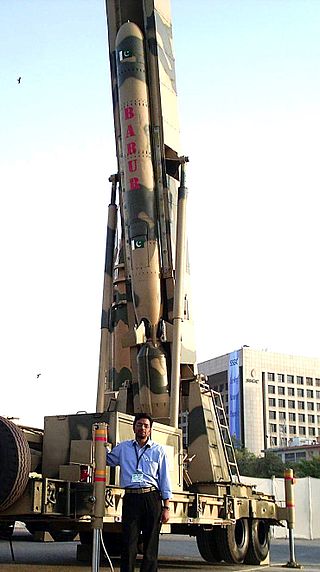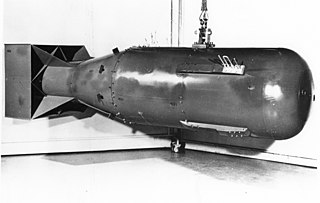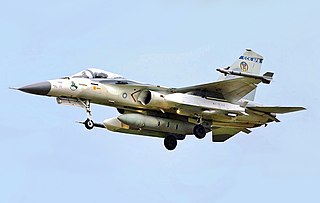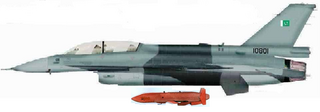
A cruise missile is an unmanned self-propelled guided vehicle that sustains flight through aerodynamic lift for most of its flight path and whose primary mission is to place an ordnance or special payload on a target. Cruise missiles are designed to deliver a large warhead over long distances with high precision. Modern cruise missiles are capable of traveling at high subsonic, supersonic, or hypersonic speeds, are self-navigating, and are able to fly on a non-ballistic, extremely low-altitude trajectory.

The AGM-86 ALCM is an American subsonic air-launched cruise missile (ALCM) built by Boeing and operated by the United States Air Force. This missile was developed to increase the effectiveness and survivability of the Boeing B-52G and B-52H Stratofortress strategic bombers, allowing the aircraft to deliver its payload from a great distance. The missile dilutes an enemy's forces ability to respond and complicates air defense of its territory.
The Ghaznavi, is a land-based short range ballistic missile, currently in military service with the strategic command of the Pakistan Army.

The Babur is an all-weather, subsonic cruise missile developed and designed by the National Defence Complex (NDC) of Pakistan.

The Popeye is a family of air-to-surface missiles developed and in use by Israel, of which several types have been developed for Israeli and export users. A long-range submarine-launched cruise missile variant of the Popeye Turbo has been speculated as being employed in Israel's submarine-based nuclear forces. The United States operated the Popeye under a different designation according to US naming conventions as the AGM-142 Have Nap.

The AGM-158 Joint Air-to-Surface Standoff Missile is a low detection standoff air-launched cruise missile developed by Lockheed Martin for the United States Armed Forces. It is a large, stealthy long-range weapon with a 1,000-pound (450 kg) armor piercing warhead. It completed testing and entered service with the U.S. Air Force in 2009, and has entered foreign service in Australia, Finland, and Poland as of 2014. An extended range version of the missile, the AGM-158B JASSM-ER, entered service in 2014 as well as an anti-ship derivative, the AGM-158C LRASM in 2018. By September 2016, Lockheed Martin had delivered 2,000 total JASSMs comprising both variants to the USAF. In August 2024 the US was reportedly considering supplying JASSM missiles to Ukraine.

The Abdali is a land-based tactical ballistic missile currently in military service with the strategic command of the Pakistan Army.
The Air Weapons Complex (AWC), operated under the National Engineering and Scientific Commission (NESCOM), is a Pakistani research and development entity. Established in 1992 by the Pakistan Air Force, it specialises in advancing airborne applications of explosive engineering.
Standoff weapons are missiles or bombs which may be launched from a distance sufficient to allow attacking personnel to evade the effect of the weapon or defensive fire from the target area. Typically, they are used against land- and sea-based targets in an offensive operation. The name is derived from their ability to engage the target while standing off outside the range at which the defenders are likely to engage the attacker. Typical stand-off weapons include cruise missiles, glide bombs and short-range ballistic missiles.

A nuclear triad is a three-pronged military force structure of land-based intercontinental ballistic missiles (ICBMs), submarine-launched ballistic missiles (SLBMs), and strategic bombers with nuclear bombs and missiles. Countries build nuclear triads to eliminate an enemy's ability to destroy a nation's nuclear forces in a first-strike attack, which preserves their own ability to launch a second strike and therefore increases their nuclear deterrence.
The Shaheen-II, is a land-based medium-range ballistic missile currently in deployed in military service with the strategic command of the Pakistan Army.

The Wan Chien is an air to ground cruise missile developed and produced by the National Chung-Shan Institute of Science and Technology (NCSIST) of Taiwan.

The Shaheen-I, is a land-based short-range ballistic missile designed and developed by the National Defence Complex and National Engineering & Science Commission.

The Hatf Program was the classified program by the Ministry of Defence (MoD) of Pakistan for the comprehensive research and the development of guided missiles. Initiatives began in 1986–87 that also received support from Prime Minister Benazir Bhutto in a direct response to India's equivalent program in 1989.

The Ra'ad, is a subsonic, standoff air-launched cruise missile (ALCM) jointly designed and developed by the National Engineering & Scientific Commission (NESCOM) and Air Weapons Complex.

The SOM is a next-generation autonomous, stealth, high precision air-launched cruise missile developed by TÜBİTAK SAGE, Defence Research and Development Institute of Turkey. It was first revealed during the 100th anniversary celebrations of the Turkish Air Force at the Çiğli Air Base in İzmir, on 4 June 2011. Developed since 2006, the SOM is Turkey's first domestic guided missile for striking both stationary and moving targets at a stand-off distance of over 180 kilometers. Although being developed by TÜBİTAK SAGE which still holds authority over the design of the missile, ROKETSAN has been given the role of manufacturing and marketing the missile for export.

An air-launched cruise missile (ALCM) is a cruise missile that is launched from a military aircraft. Current versions are typically standoff weapons which are used to attack predetermined land and naval targets with conventional, nuclear or thermonuclear payloads.
The AGM-181 Long Range Stand Off Weapon (LRSO) is a nuclear-armed air-launched cruise missile under development by Raytheon Technologies that will replace the AGM-86 ALCM.









